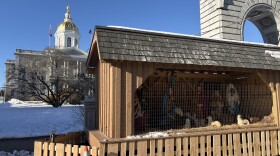As the snow starts to melt you might notice a stark contrast in the landscape. Maybe you were driving down the highway and noticed one shoulder was covered with snow while the other side was bare with a faint tinge of spring green shoots. The cause? Slope and aspect.
Slope refers to the steepness of the land and aspect refers to the direction the land is facing. Slope and aspect determine how much sunlight a given piece of land receives. The landscape isn't equally endowed and that's most evident this time of year. The best place to see this contrast is an east-west highway.
Imagine you're on Rout 4 east. Out the passenger side the embankment faces north. It remains snowy this time of year because it's just not getting sunlight. Trees cast shade while the sun is streaming from the southern horizon. The embankment on the driver's side gets more of that direct sunlight. The snow has melted and some plants are beginning to stir.
In the spring, the first places that green up are flat, open pastures or land that's angled to the south, facing the sun - the way you'd angle your solar panels to get the most energy. The lack of direct sunlight on the passenger side keeps north-facing sites cooler and more damp. This influences what kinds of trees tend to grow there. Hemlock, for example, tends to favor cooler, shady damp sites.
Meanwhile on the driver's side, the snow melts faster and it becomes warmer and drier. Trees like white pine and red oak grow best under these conditions. Where there are oak trees there are acorns and you may also find beechnuts and shagbark hickory nuts. This makes the left embankment a source of food and warmth for animals - a habitat hotspot!
Deer, for instance, seek out early bare ground; the greenest pastures where they find early green shoots and sprouts - a welcome meal after months of eating bitter needles, bark and twigs. You may also find signs of bears and turkey. These hotspots provide warm sun, food... throw in some nearby ice-free water and it becomes a magnet for wildlife by April.
Woodland seeps ringed with mosses and ferns are also an early oasis in the snowy forest for wildlife looking to fuel up. Snow melts faster and wetlands, seeps and springs green-up faster compared to the shady forest.
It's warming up out there and there's plenty to see! Take a moment to enjoy the beginning of spring. Get outside, scope out the landscape and grab a bite to eat.









